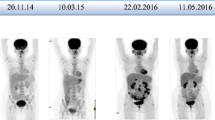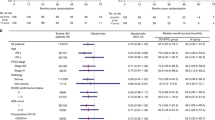Abstract
Introduction
Intraperitoneal chemotherapy preceded by cytoreductive surgery should be the standard of care in the treatment of advanced epithelial ovarian cancer. This combination has been extensively examined in both the clinical and preclinical settings with favourable oncologic outcomes. Unfortunately, despite the existence of these evidence-based data, this management strategy remains underutilised.
Materials and methods
We review and discuss the role of intraperitoneal chemotherapy with particular emphasis about the pharmacokinetics and pharmacodynamics aspects, the mode of administration, the reported side effects, the compliance of the patients and the clinical ongoing studies.
Conclusions
Further studies investigating the pharmacokinetics and pharmacodynamics aspect of IP route may help to reduce toxicity pending more effective treatments.




Similar content being viewed by others
References
Siegel R, Naishadham D, Jemal A (2012) Cancer Statistics 2012. CA Cancer J Clin 62:10–29
Young R, Walton L, Ellendberg S et al (2011) Adjuvant therapy in stage I and stage II epithelial ovarin cancer. N Engl J Med 322:1021–1027
Schorge JO, Garrett LA, Goodman A (2011) Cytoreductive surgery for advanced ovarian cancer: quo vadis? Oncology (Williston Park) 25(10):928–934
Bristow R, Tomacruz R, Armstrong D et al (2002) Survival effect of maximal cytoreductive surgery for advanced ovarian carcinoma during the platinum era: a meta-analysis. J Clin Oncol 20:1248–1259
du Bois A, Quinn M, Thigpen T et al (2005) 2004 consensus statements on the management of ovarian cancer: final document of the 3rd International Gynecologic Cancer Intergroup Ovarian Cancer Consensus Conference (GCIG OCCC 2004) Ann Oncol 16 (Suppl.8):viii7–viii12
Gadducci A, Carnino F, Chiara S et al (2000) Intraperitoneal versus intravenous cisplatin in combination with intravenous cyclophosphamide and epidoxorubicin in optimally cytoreduced advanced epithelial ovarian cancer: a randomized trial of the Gruppo Oncologico Nord-Ovest. Gynecol Oncol 76:157–162
Markman M, Bundy BN, Alberts DS et al (2001) Phase III trial of standard-dose intravenous cisplatin plus paclitaxel versus moderately high-dose carboplatin followed by intravenous paclitaxel and intraperitoneal cisplatin in small-volume stage III ovarian carcinoma: an intergroup study of the Gynecologic Oncology Group, Southwestern Oncology Group, and Eastern Cooperative Oncology Group. J Clin Oncol 19:1001–1007
Yen MS, Juang CM, Lai CR et al (2001) Intraperitoneal cisplatin-based chemotherapy vs. intravenous cisplatin-based chemotherapy for stage III optimally cytoreduced epithelial ovarian cancer. Int J Gynaecol Obstet 72(1):55–60
Armstrong DK, Bundy B, Wenzel L et al (2006) Intraperitoneal cisplatin and paclitaxel in ovarian cancer. N Engl J Med 354:34–43
Alberts DS, Liu PY, Hannigan EV et al (1996) Intraperitoneal cisplatin plus intravenous cyclophosphamide versus intravenous cisplatin plus intravenous cyclophosphamide for stage III ovarian cancer. N Engl J Med 354(1):34–43
Kirmani S, Braly PS, McClay EF et al (1994) A comparison of intravenous versus intraperitoneal chemotherapy for the initial treatment of ovarian cancer. Gynecol Oncol 54(3):338–344
Polyzos A, Tsavaris N, Kosms C et al (1999) A comparative study of intraperitoneal carboplatin versus intravenous carboplatin with intravenous cyclophosphamide in both arms as initial chemotherapy for stage III ovarian cancer. Oncology 56(4):291–296
Yen MS, Twu NF, Lai CR et al (2009) Importance of delivered cycles and nomogram for intraperitoneal chemotherapy in ovarian cancer. Gynecol Oncol 114(3):415–419
Zylberberg B, Ravina JH, Salat-Baroux J et al (1986) Polychemotherapy of ovarian cancer via combined intravenous and intraperitoneal routes. Technic and preliminary result. J Gynecol Obstet Biol Rep 15(5):671–676
Warrick C (1744) An improvement on the practice of tapping; whereby that operation, instead of a relief for symptoms, becomes an absolute cure for an ascites, exemplified in the case of Jane Roman; and recommended to the consideration of the royal society, by Christopher Warrick, of Truro, surgeon. Phil Trans 43:12–19
Weisberger AS, Levine B, Storaasli JP (1955) Use of nitrogen mustard in treatment of serous effusions of neoplastic origin. JAMA 159:1704–1707
Rutledge F, Burns B (1966) Chemotherapy for advanced ovarian cancer. Am J Obstet Gynecol 96:761–770
Dedrick RL, Myers CE, Bungay PM et al (1978) Pharmacokinetic rationale for peritoneal drug administration in the treatment of ovarian cancer. Cancer Treat Rep 62:1–9
Jones RB, Myers CE, Guarino AM, Dedrick RL, Hubbard SM, DeVita VT (1978) High volume intraperitoneal chemotherapy (“belly bath”) for ovarian cancer. Pharmacologic basis and early results. Cancer Chemother Pharmacol 1(3):161–166
Barakat RR, Almadrones L, Venkatraman ES et al (1998) A phase II trial of intraperitoneal cisplatin and etoposide as consolidation therapy in patient with stage II-IV epithelial ovarian cancer following negative surgical assessment. Gynecol Oncol 69(17):22
Braly PS, Berek JS, Blessing JA et al (1995) Intraperitoneal administration of cisplatin and 5-fluorouracil in residual ovarian cancer: a phase II Gynecology Oncology Group Trial. Gynecol Oncol 56:164–168
de Jong RS, Willemse PH, Boonstra H et al (1995) Phase II study of intraperitoneal cisplatin plus systemic etoposide as second-line treatment in patients with small volume residual ovarian cancer. Eur J Cancer 31A:709–713
Feun LG, Blessing JA, Major FJ et al (1998) A phase study of intraperitoneal cisplatin and thiotepa in residual ovarian carcinoma: a Gynecology Oncology Group Study. Gynecol Oncol 71:410–415
Bergman F (1966) Carcinoma of the ovary: a clinicopathological study of 86 autopsied cases with special reference to mode of spread. Acta Obstet Gynaecol 45:211–231
Los G, Verdegaal E, Mutsaers P et al (1991) Penetration of carboplatin and cisplatin into rat peritoneal tumor after intraperitoneal chemotherapy. Cancer Chemother Pharmacol 28:159–165
Dedrick R, Flessner M (1997) Pharmacokinetic problems in peritoneal drug administration: tissue penetration and surface exposure. Review. J Nat Cancer Inst 89:480–487
Baron MA (1941) Structure of the intestinal peritoneum in man. Am J Anat 69:439–497
Stelin G, Rippe B (1990) A phenomenological interpretation of the variation in dialysate volume with dwell time in CAPD. Kidney Int 38:465–472
De Lima Vazquez V, Stuart OA, Mohamed F et al (2003) Extent of parietal peritonectomy does not change intraperitoneal chemotherapy pharmacokinetics. Cancer Chemother Pharmacol 52:108–112
William M, McGuire P, MD, William J et al (1996) Cyclophosphamide and cisplatin compared with paclitaxel and cisplatin in patients with stage III and stage IV ovarian cancer. N Engl J Med, 334:1–6
Go RS, Adjei AA (1999) Review of the comparative pharmacology and clinical activity of cisplatin and carboplatin. J Clin Oncol 17:409–422
Ozols RF, Bundy BN, Greer BE et al (2003) Phase III trial of carboplatin and paclitaxel compared with cisplatin and paclitaxel in patients with optimally resected stage III ovarian cancer: a Gynecologic Oncology Group study. J Clin Oncol 21:3194–3200
Burger RA, Brady MF, Bookman MA et al (2010) Phase III trial of bevacizumab (BEV) in the primary treatment of advanced epithelial ovarian cancer (EOC), primary peritoneal cancer (PPC), or fallopian tube cancer (FTC): a Gynecologic Oncology Group study. J Clin Oncol 28(suppl):18s
Banerjee S, Gore M (2009) The future of targeted therapies in ovarian cancer. Oncologist 14:706–716
Sessa C, De Braud F, Perotti A et al (2005) Trabectedin for women with ovarian carcinoma after treatment with platinum and taxanes fails. J Clin Oncol 23:1867–1874
Yong-Man K, Shin Wha L, Dae-Yeon K et al (2010) The efficacy and toxicity of belotecan (CKD-602), a camptothecin analogue topoisomerase I inhibitor, in patients with recurrent or refractory epithelial ovarian cancer. J Chem 3:197–200
National Cancer Institute (2006) NCI clinical announcement: intraperitoneal chemotherapy for ovarian cancer (Internet) Bethesda, MD: National Cancer Institute. Available from: http://ctep.cancer.gov/highlights/docs/clin_annc_010506.pdf
Jaaback K, Johnson N, Lawrie TA (2011) Intraperitoneal chemotherapy for the initial management of primary epithelial ovarian cancer. Cochrane Dat Syst Rev 9(11):CD005 340
Walker JL, Huang H, Armstrong D et al (2006) Intraperitoneal catheter outcomes in a phase III trial of intravenous versus intraperitoneal chemotherapy in optimal stage III ovarian and primary peritoneal cancer: a Gynecologic Oncology Group study. Gynecol Oncol 100:27–32
Segna RA, Dottino PR, Jennings TS et al (1993) Feasibility of intraoperative administration of chemotherapy for gynecologic malignancies: assessment of acute postoperative morbidity. Gynecol Oncol 48:227–231
Howell SH (2009) Novel strategies for enhancing the efficacy of intraperitoneal chemotherapy for patients with ovarian cancer. In: Boneti A, Leone R, Muggia FM, Howell SB (eds) Platinum and other heavy metal compounds in cancer chemotherapy. Humana Press, pp 335–341. doi:10.1007/978-1-60327-459-3_37
Milam MR, Sood A, King S et al (2007) Supracervical hysterectomy in patient with advanced epithelial ovarian cancer. Obstet Gynecol 109(3):641–646
Sugarbaker PH, Graves T, DeBruijn E et al (1990) Early postoperative intraperitoneal chemotherapy as an adjuvant therapy to surgery for peritoneal carcinomatosis from gastrointestinal cancer: pharmacological studies. Cancer Res 50:5790–5794
Markman M, Walker JL (2006) Intraperitoneal chemotherapy of ovarian cancer: a review, with a focus on practical aspects of treatment. J Clin Oncol 24:988–994
Markman M, Rowinsky E, Hakes T et al (1992) Phase I trial of intraperitoneal taxol: a Gynecologic Oncology Group study. J Clin Oncol 10:1485–1491
Francis P, Rowinsky E, Schneider J et al (1995) Phase I feasibility and pharmacologic study of weekly intraperitoneal paclitaxel: A Gynecologic Oncology Group pilot study. J Clin Oncol 13:2961–2967
Rowan K (2009) Intraperitoneal therapy for ovarian cancer: why has it not became a standard? J NCI 101(11):775–777
Conflict of interest
The authors have no conflicts of interest to disclose.
Author information
Authors and Affiliations
Corresponding author
Rights and permissions
About this article
Cite this article
Grosso, G., Rossetti, D., Coccolini, F. et al. Intraperitoneal chemotherapy in advanced epithelial ovarian cancer: a survey. Arch Gynecol Obstet 290, 425–434 (2014). https://doi.org/10.1007/s00404-014-3252-2
Received:
Accepted:
Published:
Issue Date:
DOI: https://doi.org/10.1007/s00404-014-3252-2




